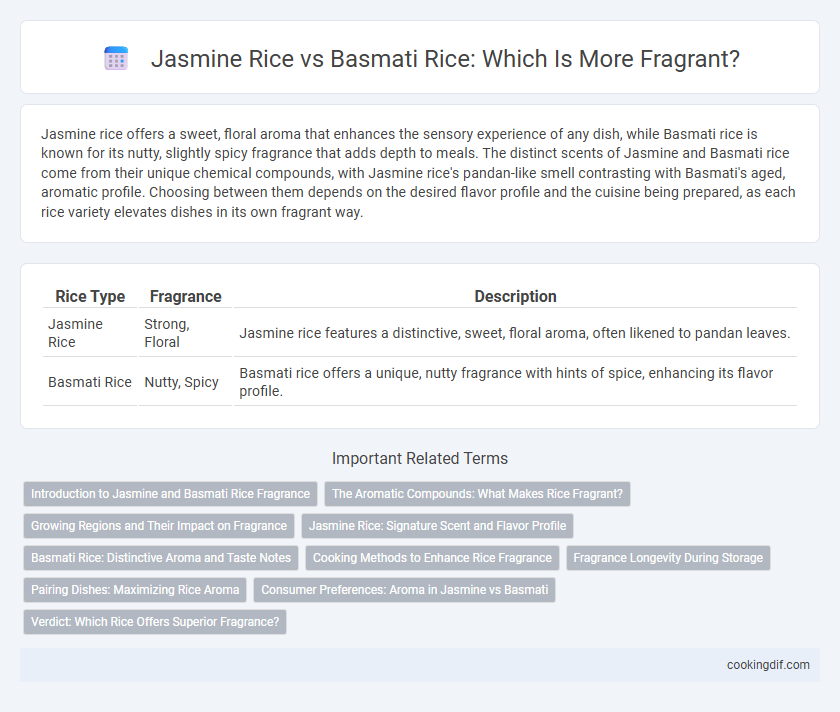Jasmine rice offers a sweet, floral aroma that enhances the sensory experience of any dish, while Basmati rice is known for its nutty, slightly spicy fragrance that adds depth to meals. The distinct scents of Jasmine and Basmati rice come from their unique chemical compounds, with Jasmine rice's pandan-like smell contrasting with Basmati's aged, aromatic profile. Choosing between them depends on the desired flavor profile and the cuisine being prepared, as each rice variety elevates dishes in its own fragrant way.
Table of Comparison
| Rice Type | Fragrance | Description |
|---|---|---|
| Jasmine Rice | Strong, Floral | Jasmine rice features a distinctive, sweet, floral aroma, often likened to pandan leaves. |
| Basmati Rice | Nutty, Spicy | Basmati rice offers a unique, nutty fragrance with hints of spice, enhancing its flavor profile. |
Introduction to Jasmine and Basmati Rice Fragrance
Jasmine rice is celebrated for its naturally sweet, floral fragrance, often described as popcorn-like, which arises from the aromatic compound 2-acetyl-1-pyrroline. Basmati rice features a distinct nutty and spicy aroma, enriched by the same compound at higher concentrations, giving it a richer scent profile. Both varieties contain varying levels of this key aromatic compound, shaping their unique olfactory identities prized in global cuisines.
The Aromatic Compounds: What Makes Rice Fragrant?
Jasmine rice and Basmati rice are both prized for their distinctive aromas, primarily due to the presence of 2-acetyl-1-pyrroline (2-AP), a key aromatic compound. Jasmine rice contains higher levels of 2-AP, giving it a sweet, floral fragrance, while Basmati rice features a more nuanced, nutty scent attributed to additional compounds like aldehydes and alcohols. The unique combination and concentration of these aromatic compounds define the signature smell and cooking appeal of each rice variety.
Growing Regions and Their Impact on Fragrance
Jasmine rice primarily grows in Thailand and Cambodia, where the humid, tropical climate enhances its naturally floral, pandan-like aroma. Basmati rice is cultivated mainly in the foothills of the Himalayas across India and Pakistan, where the cooler temperatures and distinct soil composition contribute to its nutty, spicy fragrance. The unique environmental factors of these growing regions directly influence the intensity and character of each rice variety's signature scent.
Jasmine Rice: Signature Scent and Flavor Profile
Jasmine rice is renowned for its distinctive floral aroma, often described as pandan-like, which sets it apart from basmati rice's nutty fragrance. Its soft, slightly sticky texture enhances the sensory experience, making it ideal for Southeast Asian cuisines. The rich, aromatic profile of jasmine rice pairs well with flavorful dishes, providing a fragrant base that complements spices and herbs.
Basmati Rice: Distinctive Aroma and Taste Notes
Basmati rice is renowned for its distinctively aromatic fragrance, characterized by a nutty and floral scent with subtle hints of popcorn. This long-grain variety offers a unique taste profile that is more complex and robust compared to jasmine rice, making it a favored choice in Indian and Middle Eastern cuisines. Its natural aroma, attributed to the compound 2-acetyl-1-pyrroline, enhances the flavor of dishes without overpowering other ingredients.
Cooking Methods to Enhance Rice Fragrance
Jasmine rice releases its signature floral aroma best when rinsed gently before cooking and steamed with the lid tightly sealed to trap the fragrant steam. Basmati rice benefits from soaking for 30 minutes prior to boiling, which elongates the grains and intensifies its nutty fragrance during the cooking process. Using methods like steaming or absorption cooking enhances the natural aromas of both Jasmine and Basmati rice, making fragrance a key factor in their culinary appeal.
Fragrance Longevity During Storage
Jasmine rice typically emits a strong, sweet floral aroma immediately after cooking, but its fragrance tends to diminish more rapidly during storage compared to Basmati rice. Basmati rice is known for its complex, nutty fragrance that remains more stable and lasts longer throughout storage periods due to its lower moisture content and aromatic compounds like 2-acetyl-1-pyrroline. Studies indicate that Basmati rice maintains its signature aroma for up to several months when stored properly, outperforming Jasmine rice in fragrance longevity.
Pairing Dishes: Maximizing Rice Aroma
Jasmine rice emits a sweet, floral aroma that pairs exceptionally well with Southeast Asian dishes like Thai curry, complementing spicy and coconut-based flavors. Basmati rice, known for its nutty, fragrant scent, enhances Indian and Middle Eastern dishes, perfectly matching robust spices such as cumin and cardamom. Selecting the right rice variety maximizes fragrance synergy, elevating the overall dining experience through complementary aromatic profiles.
Consumer Preferences: Aroma in Jasmine vs Basmati
Jasmine rice emits a sweet, floral aroma that appeals to consumers seeking a distinct, fragrant rice for Southeast Asian cuisines, while Basmati rice offers a nutty, aged scent preferred in Indian and Middle Eastern dishes. Consumer preferences for aroma often hinge on the dish's flavor profile, with jasmine's bouquet complementing lighter preparations and basmati's fragrance enhancing spiced, savory meals. The unique aroma compounds, such as 2-acetyl-1-pyrroline, are pivotal in driving these sensory distinctions and influencing buyer choice.
Verdict: Which Rice Offers Superior Fragrance?
Jasmine rice is renowned for its sweet, floral aroma that enhances Southeast Asian dishes, while Basmati rice offers a nutty, aromatic fragrance prized in Indian and Middle Eastern cuisine. Sensory tests consistently highlight Jasmine rice's more intense and lingering scent, making it ideal for those seeking a pronounced fragrance. Ultimately, Jasmine rice holds the verdict for superior fragrance due to its distinctly sweet and captivating aroma profile.
Jasmine rice vs Basmati rice for fragrance Infographic

 cookingdif.com
cookingdif.com